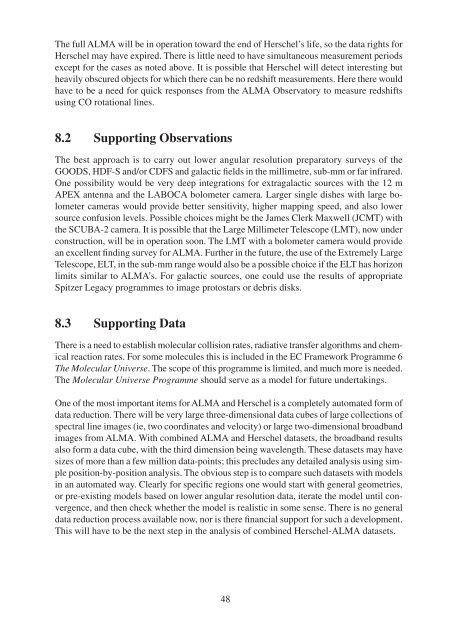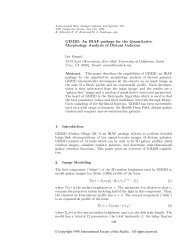4 Comparison of the ALMA and Herschel - ESO
4 Comparison of the ALMA and Herschel - ESO
4 Comparison of the ALMA and Herschel - ESO
Create successful ePaper yourself
Turn your PDF publications into a flip-book with our unique Google optimized e-Paper software.
The full <strong>ALMA</strong> will be in operation toward <strong>the</strong> end <strong>of</strong> <strong>Herschel</strong>’s life, so <strong>the</strong> data rights for<br />
<strong>Herschel</strong> may have expired. There is little need to have simultaneous measurement periods<br />
except for <strong>the</strong> cases as noted above. It is possible that <strong>Herschel</strong> will detect interesting but<br />
heavily obscured objects for which <strong>the</strong>re can be no redshift measurements. Here <strong>the</strong>re would<br />
have to be a need for quick responses from <strong>the</strong> <strong>ALMA</strong> Observatory to measure redshifts<br />
using CO rotational lines.<br />
8.2 Supporting Observations<br />
The best approach is to carry out lower angular resolution preparatory surveys <strong>of</strong> <strong>the</strong><br />
GOODS, HDF-S <strong>and</strong>/or CDFS <strong>and</strong> galactic fields in <strong>the</strong> millimetre, sub-mm or far infrared.<br />
One possibility would be very deep integrations for extragalactic sources with <strong>the</strong> 12 m<br />
APEX antenna <strong>and</strong> <strong>the</strong> LABOCA bolometer camera. Larger single dishes with large bolometer<br />
cameras would provide better sensitivity, higher mapping speed, <strong>and</strong> also lower<br />
source confusion levels. Possible choices might be <strong>the</strong> James Clerk Maxwell (JCMT) with<br />
<strong>the</strong> SCUBA-2 camera. It is possible that <strong>the</strong> Large Millimeter Telescope (LMT), now under<br />
construction, will be in operation soon. The LMT with a bolometer camera would provide<br />
an excellent finding survey for <strong>ALMA</strong>. Fur<strong>the</strong>r in <strong>the</strong> future, <strong>the</strong> use <strong>of</strong> <strong>the</strong> Extremely Large<br />
Telescope, ELT, in <strong>the</strong> sub-mm range would also be a possible choice if <strong>the</strong> ELT has horizon<br />
limits similar to <strong>ALMA</strong>’s. For galactic sources, one could use <strong>the</strong> results <strong>of</strong> appropriate<br />
Spitzer Legacy programmes to image protostars or debris disks.<br />
8.3 Supporting Data<br />
There is a need to establish molecular collision rates, radiative transfer algorithms <strong>and</strong> chemical<br />
reaction rates. For some molecules this is included in <strong>the</strong> EC Framework Programme 6<br />
The Molecular Universe. The scope <strong>of</strong> this programme is limited, <strong>and</strong> much more is needed.<br />
The Molecular Universe Programme should serve as a model for future undertakings.<br />
One <strong>of</strong> <strong>the</strong> most important items for <strong>ALMA</strong> <strong>and</strong> <strong>Herschel</strong> is a completely automated form <strong>of</strong><br />
data reduction. There will be very large three-dimensional data cubes <strong>of</strong> large collections <strong>of</strong><br />
spectral line images (ie, two coordinates <strong>and</strong> velocity) or large two-dimensional broadb<strong>and</strong><br />
images from <strong>ALMA</strong>. With combined <strong>ALMA</strong> <strong>and</strong> <strong>Herschel</strong> datasets, <strong>the</strong> broadb<strong>and</strong> results<br />
also form a data cube, with <strong>the</strong> third dimension being wavelength. These datasets may have<br />
sizes <strong>of</strong> more than a few million data-points; this precludes any detailed analysis using simple<br />
position-by-position analysis. The obvious step is to compare such datasets with models<br />
in an automated way. Clearly for specific regions one would start with general geometries,<br />
or pre-existing models based on lower angular resolution data, iterate <strong>the</strong> model until convergence,<br />
<strong>and</strong> <strong>the</strong>n check whe<strong>the</strong>r <strong>the</strong> model is realistic in some sense. There is no general<br />
data reduction process available now, nor is <strong>the</strong>re financial support for such a development.<br />
This will have to be <strong>the</strong> next step in <strong>the</strong> analysis <strong>of</strong> combined <strong>Herschel</strong>-<strong>ALMA</strong> datasets.<br />
48




